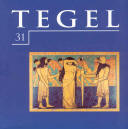 bevat artikelen over de volgende onderwerpen:
bevat artikelen over de volgende onderwerpen:
Majolicategels uit het kasteel van Egmont te Zottegem (België)
Frans Caignie en Tony Oost - page 4
In 1994 thirteen tile fragments were excavated from a cesspit on the site of Egmont Castle at Zottegem (Belgium). Eight of them formed part of one and the same floor, and this group of tile fragments with their intriguing motifs, which probably relate to the then occupants of the castle, is the focus of this study.
Three tile fragments in this group show parts of a Ptolemaic armillary sphere within a double blue octagon (ill. 1). The sphere here probably symbolizes cosmopolitanism and science. Lamoraal van Egmont, a descendant of the House of Egmont, which originated in the province of North Holland, where they were wardens of the Abbey of Egmont aan den Hoef, was a wealthy man rich in titles and estates. A great Burgundian grand seigneur who fought at the side of the Emperor Charles V, he was beheaded in 1568 at the Grote Markt in Brussels for his equivocal attitude towards the edicts and inquisition of Charles V and his son Philip II.
Another set of three tiles belonging to the same floor (ill. 3) is decorated with branches of the cross of Burgundy, which is based on the saltire. It was on this type of cross with diagonally crossing bars that Saint Andrew is believed to have been crucified. It was adopted as its emblem by the House of Burgundy, whose patron saint he was. This motif can be compared to the crossed branches on the hexagonal tiles from the church of Margaret of Austria at Bourg-en-Bresse, France (ill. 5). To judge by their iconography the remaining two tiles in this group were also part of this floor, though only one actually fits to tiles 11 and 18 (ill. 9). Does the letter E on tile 12 stand for Egmont? The design may have included a love knot with to the left, presumably, the initial S, for Sabina van Simmern, a Bavarian duchess, who married Lamoraal van Egmont in 1544.
These eight tile fragments point yet again to an Antwerp provenance, which places them in the group that includes The Vyne, Rameyen, Herkenrode, Anjum, Aduard, Breda and numerous other individual pieces. The historical context of the floor indicates a date shortly before the middle of the 16th century, a period to which a great many tiles in Antwerp museums have been dated.
The other five tiles are rather diverse in design and may have been used later to fill gaps when the floor was repaired (ills. 13, 14). They are mentioned here merely as excavation finds and reference is made to similar tiles in museum collections and publications.
Majolicanijverheid in Dordrecht
Arend Jan Gierveld - page 16
Research carried out in the Dordrecht municipal archives shows that the Van den Heuvel family of potters from Rotterdam were active from 1613 to 1648 not only in their home town and Gouda, but also in Holland’s oldest town of Dordrecht. Articles of apprenticeship dating from the beginning of this period provide an insight into training of apprentices in throwing and decorating. This research to some extent corrects and completes the data contained in the standard publications by Hoynck van Papendrecht (1920) and Hudig (1933).
De brouwersputstoel op tegels
J. Ayolt Brongers - page 23
In the series of wall tiles with large human figures and buildings one sometimes comes across a depiction of a brewers’ water drawing scaffold (ills. 1, 2, 3). In the 17th century a structure of this type was used to draw comparatively clean water from a river (or a barge that transported water to a town). It was hauled up to the platform and poured into a wooden trough which led to the brewery. Illustration 4 shows how it worked. The author of the article resides at Amersfoort in the heart of the Netherlands. This town owes its historic reputation for beer brewing to the pure water from numerous streams in the neighbouring district of the Veluwe. A street plan of Amersfoort from about 1645 shows several of these brewers’ scaffolds (ill. 5).
Symmetrie in Drenthe
A. Blaauw - page 26
Prior to the 1963-1965 restoration there were two large fireplaces with 18th century blue and white tiles in the old farmhouse ‘Zuidvelde 27’ at Norg in the province of Drenthe (the Netherlands). The older one comprised on either side a band of Bible tiles (ill. 1), which were made in Utrecht in the first half of the 18th century, flanked by a column of ornamental tiles. The central space was filled with landscape tiles at a later date. In contrast with what might have been expected, the tiler did not arbitrarily select from the various designs, but aimed at a symmetrical composition of the tiled wall. The other fireplace was decorated entirely with the same type of landscape tiles, and there, too, it is clear that symmetry was the objective.
'De Twee Laurierbomen' De laatste Amsterdamse tegelbakkerij (1808 - ca. 1854)
Wim van de Loo, Jaap Rohof, Jan Pluis - page 30
A hitherto unknown tile works was active in Amsterdam from 1808 to 1842, perhaps to 1854. In 1807 Herman Schneck, a merchant of German origin, bought the property ‘De Twee Laurierbomen’ on Lauriergracht, now no. 12, in Amsterdam. There, together with his son Jan Carel he set up a complete tile works. This tile factory, the only one in Amsterdam after 1816, did good business and expansion followed expansion. Its output was substantial, including large quantities of tiles depicting biblical scenes and landscapes in blue and purple, which are found mostly in the Zaan region and elsewhere in the province of North Holland, but also in northern Germany. Polychrome tiles, tile pictures and unusual tile sizes also occur.
Het ‘koek en zoopje’
Lida Brouwer-Brand - page 41
A 'koek-en-zoopje' is part of the fun of ice sports. ‘Koek’ means cake, ‘zoopje’ is an old Dutch word for a sip or swig. A 19th century children’s print, published by J. Noman, shows what a 'koek-en-zoopje' tent on a frozen lake looked like. The shape of the tent, the poles, flags and various objects hanging outside are typical features. These 'koek-en-zoopje' tents can also be found on 18th and 19th century tiles.
Sectiel van de Porceleyne Fles. De ultieme tegel, maar niet voor verzamelaars.
Bart Verbrugge - page 43
Sectiel (from Latin secare, to cut) is a unique type of ceramic decoration in buildings, which was introduced by De Porceleyne Fles at the World Fair in Paris in 1900. Unique in that the tiles are not rectangular but follow the contours of the design. Moreover, very unusual ceramic techniques were applied (pâte-sur-pâte technique). This product was the result of the teamwork between the artistic creator Adolf Le Comte and the technical expert Heinrich Wilhelm Mauser, and the four tile pictures submitted at the World Fair deservedly won a gold medal.
Between 1900 and 1914 sectiel was ordered by architects in the Netherlands - also abroad - for use in interiors and on façades. Most early designs are in Adolf Le Comte’s floral art nouveau-like style.
Later the second artist at the factory, Leon Senf, also designed several sectiel pictures. The Theetuin (Tea Garden) is a fine example of his work.
The Dutch Tile Museum at Otterlo has availed itself of the rare opportunity to acquire this picture. Fortunately most sectiel pictures are still in situ, on inner and outer walls of buildings and houses.
'Een tegel die er uit springt'
Gerard D. Liefhebber - page 49
A 17th century tile depicting a 'townscape with church' was found among a number of interesting animal tiles. The question arises: was the design on this tile an original design or a copy of an existing drawing or print? This unusual tile invites further research.
Bibliography 2002-2003
page 50





